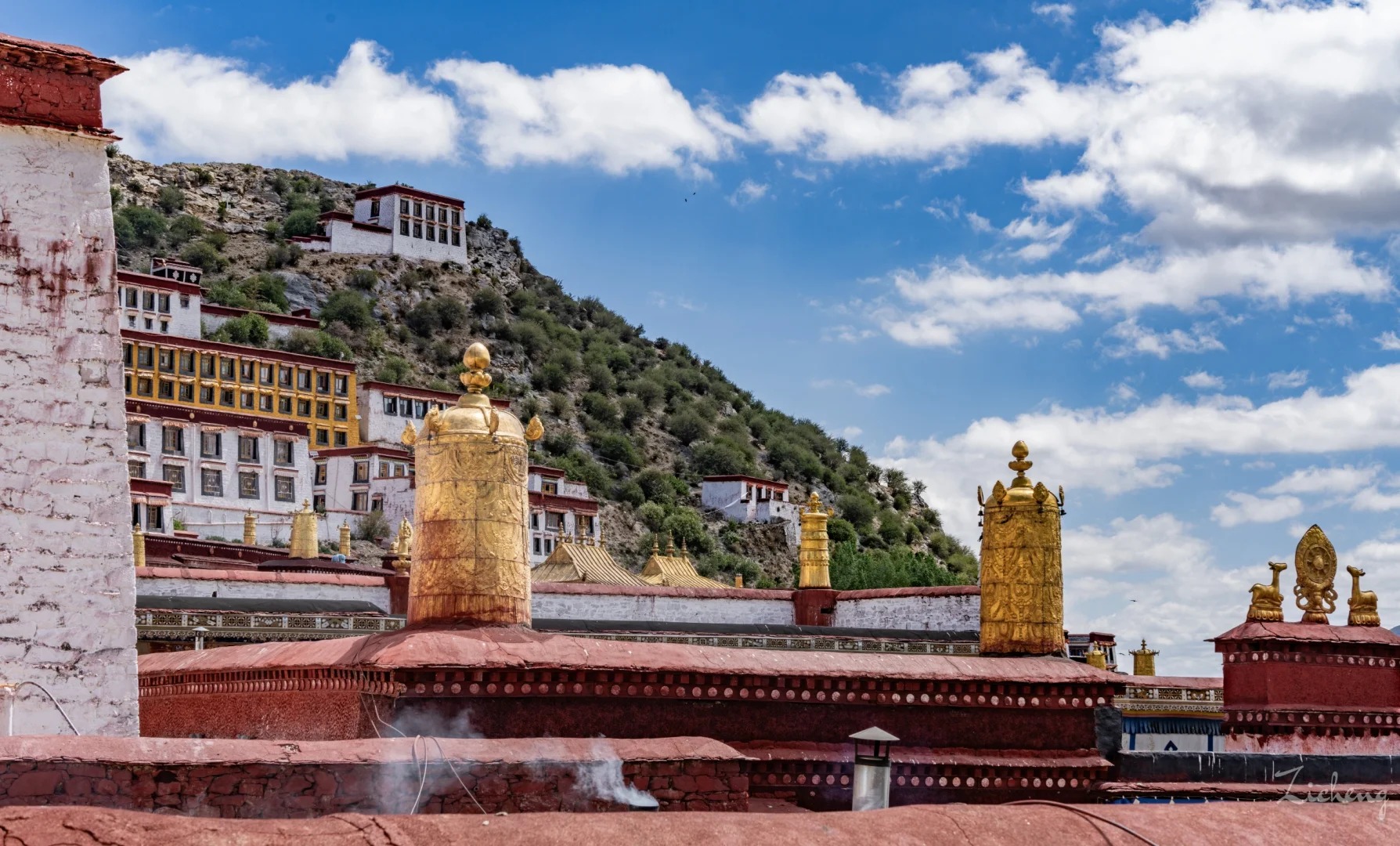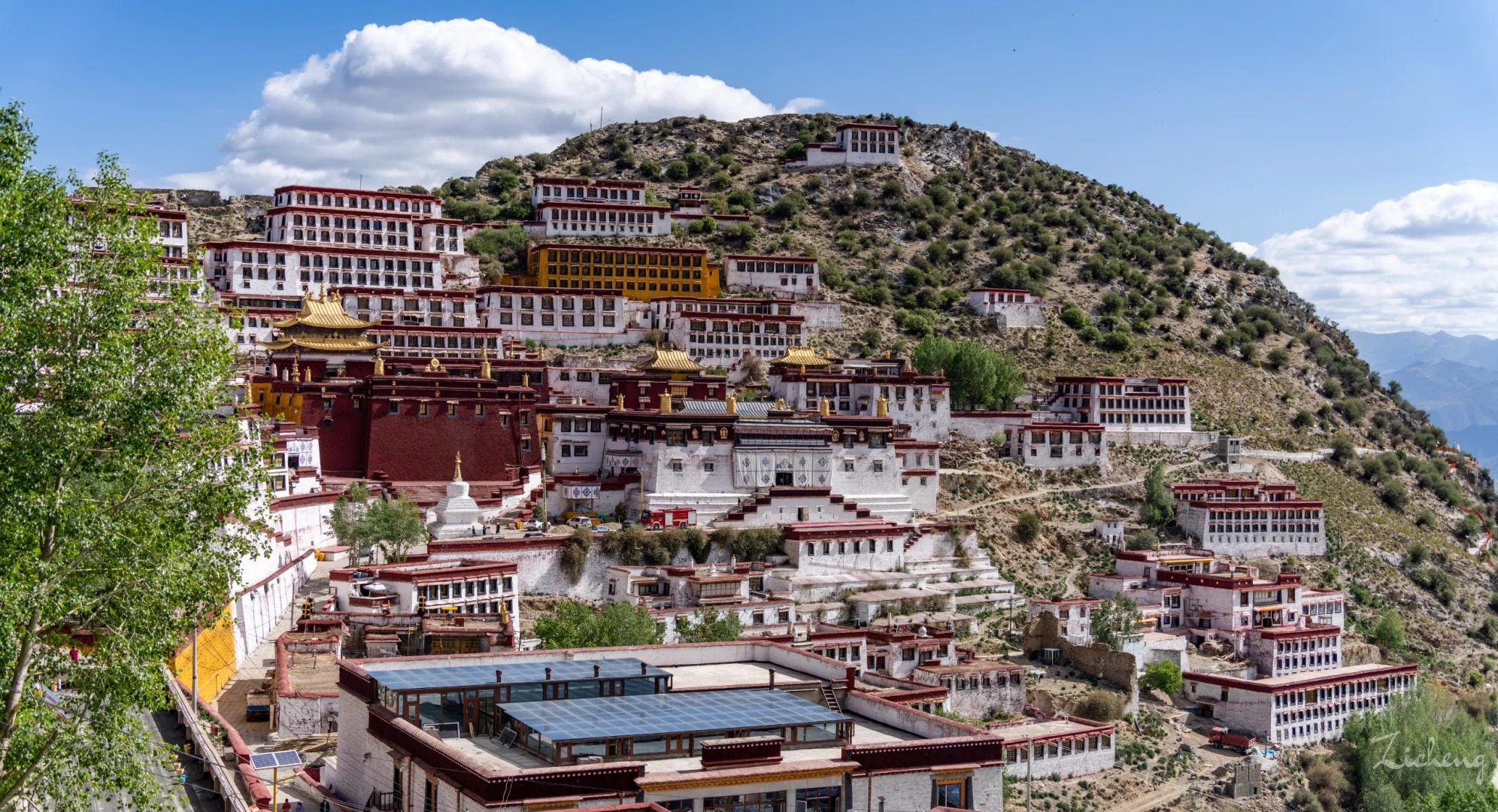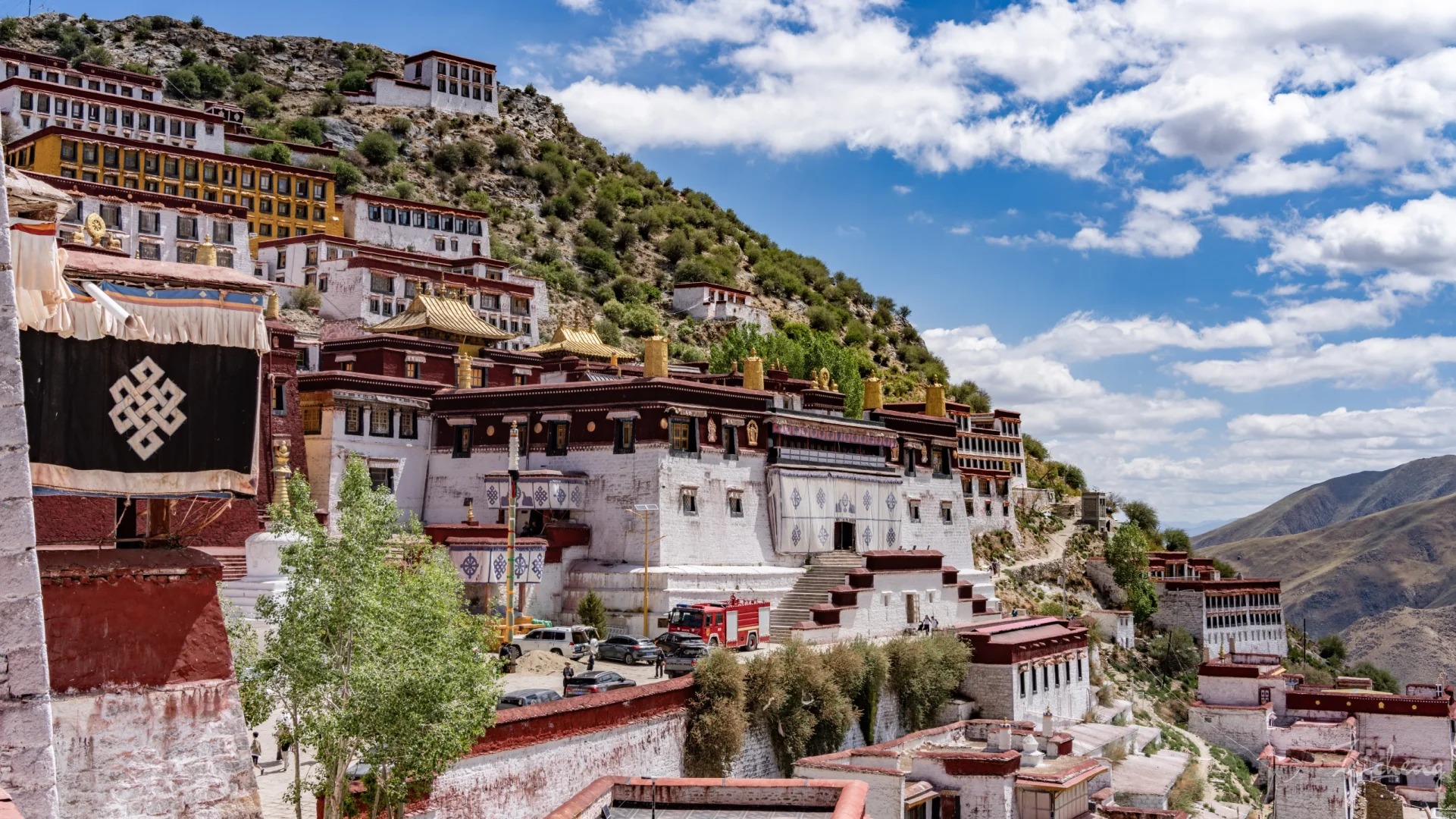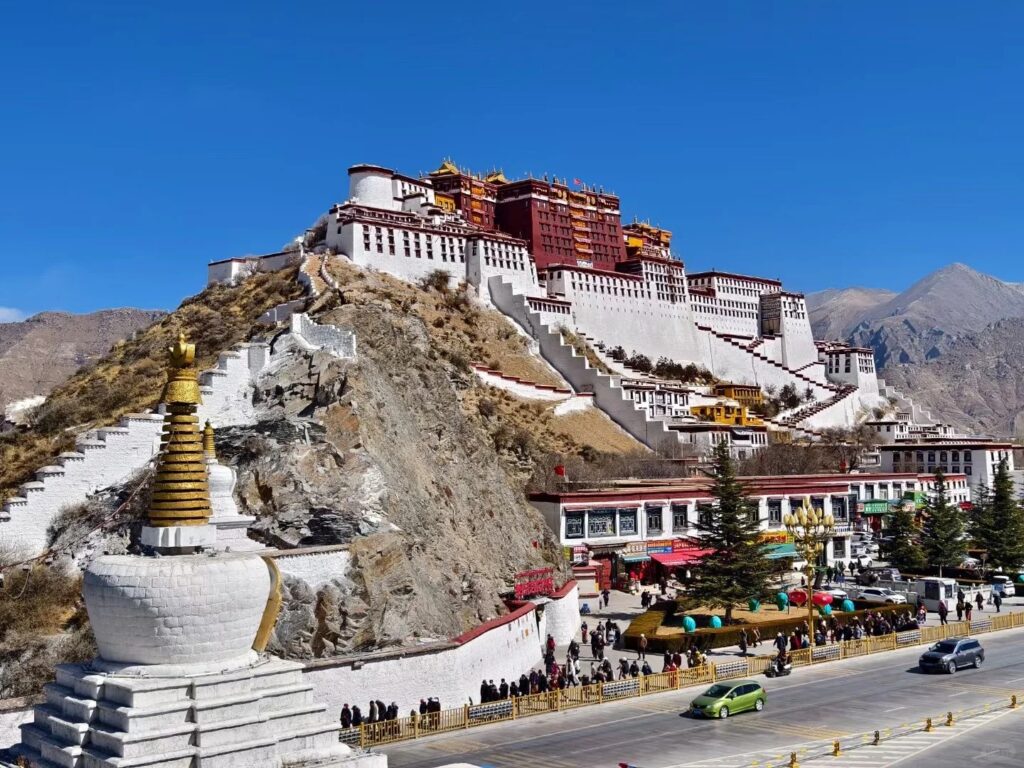Visiting Information
| Information | Details |
|---|---|
| Chinese Name | 甘丹寺 (Gāndān Sì) |
| Location and Address | Dagzê County, Lhasa, Tibet Autonomous Region, China |
| Opening Time/Hours | 9:00 AM – 4:00 PM daily |
| Entrance Fee | 40 CNY for adults |
| How to Get There | By Bus: No direct public bus available By Taxi: About 1.5 hours drive from Lhasa city center (No metro service in Lhasa) |
| Best Time for Visit | May to October, especially during the Ganden Thangka Festival (usually in June or July) |
| Contact Info | Phone: +86 891 6352225 |
Overview
Ganden Monastery, also known as Ganden Namgyeling, is one of the “great three” Gelug university monasteries of Tibet, along with Sera and Drepung monasteries. Located on Wangbur Mountain, 47 kilometers east of Lhasa, Ganden Monastery sits at an altitude of 4,300 meters, offering breathtaking views of the surrounding landscape. Founded in 1409 by Je Tsongkhapa, the founder of the Gelug school of Tibetan Buddhism, Ganden holds immense historical and spiritual significance.
Historical Background
Ganden Monastery was established in 1409 by Je Tsongkhapa, marking the beginning of the Gelug tradition of Tibetan Buddhism. The name “Ganden” means “joyful” in Tibetan and is the Tibetan name for Tuṣita, the heaven where the bodhisattva Maitreya is said to reside. As the first and main Gelug monastery, Ganden became the seat of the Ganden Tripa, the head of the Gelug school. Throughout its history, the monastery has been a center of Buddhist learning and played a significant role in Tibetan religious and political affairs. Like many Tibetan monasteries, Ganden suffered extensive damage during the Cultural Revolution in the 1960s but has since been partially restored and continues to function as an important religious institution.

Architectural Features
- Main Assembly Hall (Tsokchen): The heart of Ganden Monastery, the Main Assembly Hall, is an impressive structure that can accommodate thousands of monks. It features towering pillars, intricate murals depicting Buddhist teachings and deities, and numerous statues. The hall houses important religious artifacts and serves as the primary location for monastic gatherings, prayers, and ceremonies.
- Serdung: This is the golden tomb of Je Tsongkhapa, the founder of the monastery. The Serdung is a highly revered site within Ganden, adorned with gold, precious stones, and intricate carvings. It contains the mummified body of Tsongkhapa and is a focal point for pilgrims and visitors paying their respects to the great teacher.
- Yangpachen Hall: This hall is dedicated to protective deities and houses impressive statues and thangkas (Tibetan Buddhist paintings) of various protector deities of the Gelug school. The atmospheric interior, often filled with the scent of incense and the sound of chanting, provides visitors with a glimpse into Tibetan Buddhist rituals and iconography.
- Kora Path: The circular path around the monastery, used for circumambulation by pilgrims and monks, offers stunning views of the surrounding mountains and valleys. Along the path, visitors can find prayer wheels, carved mani stones, and small shrines, making it both a spiritual journey and a scenic walk.
Cultural Importance
Ganden Monastery holds immense cultural significance in Tibetan Buddhism and Tibetan history. As the original monastery of the Gelug school, it represents the foundation of one of the most influential traditions in Tibetan Buddhism. The monastery has been a center of Buddhist scholarship, debate, and meditation for centuries, producing many renowned scholars and spiritual leaders. It plays a crucial role in preserving Tibetan Buddhist texts, art, and rituals. The annual Ganden Thangka Festival, where a giant thangka of Buddha is displayed, attracts thousands of pilgrims and showcases the living traditions of Tibetan Buddhism. Ganden’s location and architecture also exemplify the harmonious integration of spiritual practice with the natural environment, a hallmark of Tibetan culture.
Surrounding Attractions
- Drak Yerpa: Located about 16 kilometers northeast of Lhasa, Drak Yerpa is a complex of ancient meditation caves that have been used by many important figures in Tibetan Buddhism. The site offers a unique glimpse into the ascetic traditions of Tibetan Buddhism and features several small temples built into the cliffside. The panoramic views of the surrounding valleys make it a popular destination for both pilgrims and tourists.
- Tidrum Nunnery: Situated in a valley about 40 kilometers from Ganden, Tidrum Nunnery is known for its hot springs and peaceful atmosphere. The nunnery itself is small but picturesque, and visitors can enjoy the therapeutic hot springs while taking in the beautiful mountain scenery. It’s a less-visited site that offers a quieter, more contemplative experience compared to the larger monasteries.
- Chim-puk Hermitage: This remote hermitage, located about 15 kilometers north of Ganden, was a favorite meditation retreat of Je Tsongkhapa. The site consists of numerous caves where monks and yogis have meditated for centuries. The challenging hike to reach Chim-puk offers stunning views and a sense of the isolated environments sought by Tibetan ascetics for deep spiritual practice.
- Lhasa River Valley: The journey to Ganden Monastery takes visitors through the picturesque Lhasa River Valley. This scenic route offers opportunities to observe traditional Tibetan rural life, with villages, farmlands, and nomadic camps dotting the landscape. The valley’s natural beauty, with its winding river and surrounding mountains, provides numerous photo opportunities and a chance to experience Tibet’s diverse ecosystems.

Photography Opportunities
- Panoramic Views: The high altitude location of Ganden Monastery offers breathtaking panoramic views of the surrounding Tibetan plateau. Photographers can capture stunning landscapes featuring snow-capped mountains, rolling hills, and the winding Lhasa River in the distance. The best times for these shots are early morning or late afternoon when the light is soft and creates long shadows across the terrain.
- Monastic Life: Ganden provides ample opportunities to photograph the daily life of Tibetan monks. From debating sessions in the courtyards to prayer ceremonies in the assembly halls, these scenes offer a glimpse into the living traditions of Tibetan Buddhism. Be respectful and always ask permission before photographing individuals or inside temple halls.
- Architectural Details: The monastery’s unique architecture, with its white-washed walls, golden roofs, and intricate decorations, offers countless subjects for detail-oriented photography. Focus on elements like prayer wheels, carved doorways, colorful thangkas, and the interplay of light and shadow in the narrow corridors and halls.
- Kora Path: The circumambulation path around Ganden not only offers great views but also opportunities to capture pilgrims and visitors engaging in traditional practices. The path is dotted with prayer flags, mani stones, and small shrines, providing both cultural interest and visual variety to your photographs.
Modern Importance
- Preservation of Tibetan Buddhism: In the face of modernization and cultural changes, Ganden Monastery continues to play a vital role in preserving and transmitting Tibetan Buddhist teachings and practices. It remains an active center of monastic education, where traditional debates, rituals, and meditation practices are maintained and passed on to new generations of monks.
- Cultural Heritage Site: As one of Tibet’s most important historical and religious sites, Ganden Monastery serves as a living museum of Tibetan art, architecture, and spiritual traditions. Its ongoing restoration and preservation efforts contribute to maintaining Tibet’s unique cultural heritage, attracting scholars, pilgrims, and tourists from around the world.
- Ecological Awareness: The monastery’s location in a fragile high-altitude environment has made it a focal point for discussions about ecological preservation in Tibet. Monastic leaders and local communities are increasingly involved in environmental protection efforts, blending traditional Buddhist respect for nature with modern conservation practices.
- Interfaith and International Relations: Ganden Monastery, with its historical significance and continued importance in Tibetan Buddhism, plays a role in fostering interfaith dialogue and international cultural exchange. It receives visitors from various religious backgrounds and nationalities, contributing to global discussions on spirituality, cultural preservation, and the role of traditional wisdom in addressing modern challenges.

FAQ
- What is Ganden Monastery famous for?
Ganden Monastery is famous for being one of the “great three” Gelug university monasteries of Tibet, its foundation by Je Tsongkhapa (founder of the Gelug school), its stunning hilltop location, and its historical importance in Tibetan Buddhism. - What’s inside Ganden Monastery?
Inside Ganden Monastery, visitors can find the Main Assembly Hall, Je Tsongkhapa’s tomb (Serdung), numerous chapels and shrines, ancient scriptures, Buddhist artifacts, intricate murals and thangkas, and living quarters for monks. - Is Ganden Monastery free?
No, Ganden Monastery is not free. There is an entrance fee of 40 CNY for adults. - Is Ganden Monastery worth visiting?
Yes, Ganden Monastery is definitely worth visiting. It offers unique insights into Tibetan Buddhist history and culture, impressive architecture, beautiful artwork, and stunning panoramic views of the Tibetan plateau. Its historical significance and less crowded atmosphere compared to some Lhasa monasteries make it a rewarding destination. - What to do in Ganden Monastery?
At Ganden Monastery, you can:
1. Explore the Main Assembly Hall and other temple buildings
2. Visit Je Tsongkhapa’s tomb (Serdung)
3. Observe or participate in prayer sessions
4. Walk the Kora (circumambulation) path for great views
5. Learn about Tibetan Buddhist art and iconography
6. Join a guided tour to understand the monastery’s history and significance
7. Participate in the Ganden Thangka Festival if visiting in summer
8. Enjoy the panoramic views of the surrounding landscape - How do I get to Ganden Monastery in the local city?
From Lhasa, you can reach Ganden Monastery by:
1. Organized tour: Many local travel agencies offer day trips that include transportation
2. Hired vehicle or taxi: It’s about a 1.5-hour drive from Lhasa city center
3. There is no direct public bus service to Ganden Monastery
Note that Lhasa does not have a metro system. - How to visit Ganden Monastery?
To visit Ganden Monastery:
1. Check the opening hours (usually 9:00 AM – 4:00 PM daily)
2. Purchase tickets at the entrance
3. Consider hiring a local guide for better understanding of the site
4. Dress modestly and bring warm clothes as it can be cold at high altitude
5. Be mindful of altitude as Ganden is at 4,300 meters elevation
6. Respect religious customs and photography restrictions
7. Allow at least 2-3 hours for your visit
8. Visit in the morning to see more monastic activities
9. Remember to bring your passport, as it may be required for entry
10. Consider acclimatizing in Lhasa for a few days before visiting due to the high altitude





